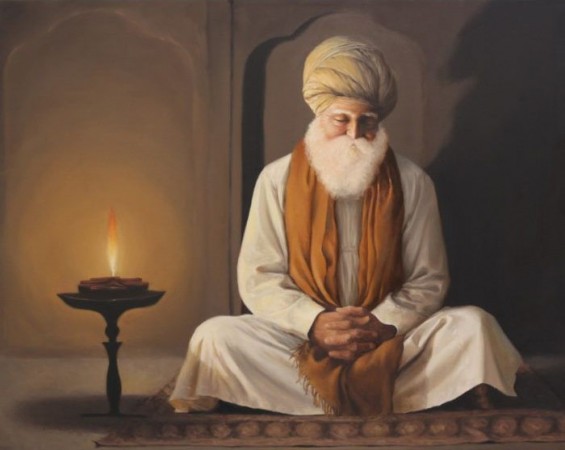
Baba Budha Singh Ji plays a crucial role in Sikh history. He was the one who applied tilaks of guruship to the Five Guru’s of Sikh. He was the first Granthi (priest) of Harmindir Sahib and laid the foundation of Dera Baba Nanak and most of the holy buildings in Amritsar.
Baba Budha Singh's actual name was BURA. He was born on October 22, 1506 A.D. His father was Sugha Randhawa and his Mother was Gauran. They lived in Kathu Nangal village of Amritsar District. After some time they settled down in Dhalla village not far away from river Ravi opposite Kartarpur.
Guru Nanak was traveling back to Kartarpur, where he was staying, on the western side of the River Ravi in the year 1524 AD with Bala. The Guru stopped to rest under a tree on the trip through the forest. He noticed a child nearby tending cattle. When the Guru called, he inquired about his village, parents, and other details. Then he instructed him to go take care of his animals. The child asked if there was anything he could do for him. The Guru claimed that at the moment, there was nothing he could do.
Also Read:Akal Takht: Eternal Thorn
Bura learned the name of the community in which the holy man resided. The following morning, he brought the Guru a pot of buttermilk with a floating piece of butter in it. He gave the Guru his meager gift with the utmost respect and humility while paying careful attention to his sermon. Bura thereafter requested the Guru to reveal the path to salvation. A boy at that young age would not be concerned with such a situation, according to Nanak. Bura insisted that he was Bura, but the Guru said that he was Burha or Budha since he spoke like an elderly man despite being young and having tremendous wisdom. Bura was then given the name Baba Budha. He changed.
Baba Budha gave his all while serving in the Guru's home. He got up early under the stars, cleaned the house, rubbed mud all over the fireplace, filled water pitchers, milked cows and buffaloes, toiled in the fields, and worked in the langar. He was constantly available to the Guru and attended all of his sermons. When Guru Nanak went on a preaching tour through the nearby villages, Baba Budha looked after the Guru's home and provided sincere devotional service to Mata Sulakhani, Sri Chand, and Lakhmi Das.
Later on, Nanak decided to nominate his successor. He chose Bhai Lehna for this purpose. One day the Guru held a special langar and then a durbar. He placed a coconut and five paise before Bhai Lehna called him Angad, and appointed him the next Guru. At the Guru's bidding, Baba Budha applied the tilak on Angad's forehead.
Also Read:Three Pillar of Sikhi : Spiritual Elevation
After leaving Kartarpur, Guru Angad set up residence at Khadur, close to the Beas River. Kartarpur was the home of Baba Budha. Sri Chand, the eldest son of Guru Nanak, was dissatisfied with his supersession in Angad's favor. The new Guru disliked offending Nanak's family in any way. In the village of Sanghar, he barricaded himself in the home of an elderly woman named Bhirai and instructed her not to reveal his identity. The Guru spent his time in meditation, and the Sikhs were unable to find him for a year and six months1. They approached Baba Budha, who guided them to Sanghar before taking them to Khadur. He convinced the Guru to resume his duties and come out of seclusion.
Also Read:The Five K’s of Sikhism
Guru Angad invented the Gurmukhi script. To popularise it, he started teaching it to the children of the Sikhs. Baba Budha also learned it and then took up the Guru's duty to teach it.
Guru Amar Das Ji was nominated for guruship, it was Baba Budha who performed the tilak ceremony. Guru Amar Das shifted his headquarters from Khadur to Goindwal to avoid any conflict over the issue of succession with Guru Angad's sons. Even there the new Guru was not left in peace.
Bhai Buddha lived up to a ripe old age and had the unique honor of anointing all of the four following Gurus. He continued to serve the Gurus with complete dedication and remained an example of holy living for the growing body of disciples.
He devoted himself zealously to tasks such as the digging of the Baoli at Goindval under the instruction of Guru Amar Das and the excavation of the sacred tank at Amritsar under Guru Ram Das and Guru Arjan. The banyan tree under which he used to sit supervising the excavation of the Amritsar pool still stands in the precincts of the Golden Temple. He subsequently retired to a bir or forest, where he tended the livestock of the Guru ka Langar.
Also Read: Khalsa Panth: Community and Faith of Sikhism